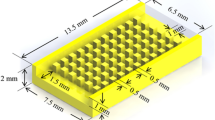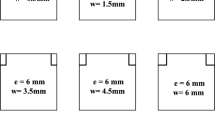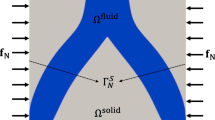Abstract
Because of high efficiency, energy conservation, simple operation, wide application range, and small size, the high-speed universal pulverizer has been well received by customers. However, its electrical motor can overheat when working, which hinders continuous operation of the pulverizer. In this study, a series of efforts were made to address this problem. Firstly, a detailed analysis of the working principle of the pulverizer was conducted and an optimization plan was proposed, consisting in punching ventilation holes on the surface of the original pulverizer. Simulations of the pulverizer flow field before and after optimization were performed. The hydrodynamic simulation results were used to conduct a steady state thermal analysis of the pulverizer, investigating the influence of the flow field on heat transfer. Additionally, experimental investigations were conducted on the pulverizer before and after optimization in order to measure and compare the parameters (motor working temperature, wind speed and temperature of the motor cooling system, vibration, noise, and pulverizing degree of the material) influencing the performance of the pulverizer. The numerical simulation results showed an increment in heat transfer caused by increment in air flow volume and velocity when air was injected into the pulverizer through bottom and side holes. Experimental results showed that the pulverizer with air injection through holes had the best performance when temperature, vibration, and refinement effect were considered as performance indicators.

















Similar content being viewed by others
References
Ying XU, Liu GF, Shu ZH (2004) Research and application status of grinding equipments for traditional Chinese medicine. China Powder Sci Technol 2:25–28
Che Z (2015) Rotor of pulveriser, WO/2015/006982
Wada T (2016) Pulveriser, absorber manufacturing apparatus provided with the same, and pulp sheet pulverizing method. US Patent 20160199849
Özer CE, Whiten WJ, Lynch AJ (2016) A multi-component model for the vertical spindle mill. Int J Miner Process 148:155–165
Shah KV, Vuthaluru R, Vuthaluru HB (2009) CFD based investigations into optimization of coal pulveriser performance: effect of classifier vane settings. Fuel Process Technol 90(9):1135–1141
Feng L, Gui W, Yang F (2010) Soft sensor modeling for mill output of duplex inlet & outlet ball pulverizer system based on an improved grey relational analysis. Chin J Sci Instrum 31(9):2062–2067
Changizi N, Kaboodanian H, Jalalpour M (2016) Stress-based topology optimization of frame structures under geometric uncertainty. Comput Methods Appl Mech Eng 315:121–140
Chi CJ, Zhou YD, Cao SQ et al (2015) Development of a pilot roller test machine for investigating the pulverizing performance of particle beds. Miner Eng 72:65–72
Nakamura H, Kan H, Takeuchi H et al (2015) Effect of stator geometry of impact pulverizer on its grinding performance. Chem Eng Sci 122(122):565–572
Archary H, Schmitz W, Jestin L (2016) Mass flow and particle size monitoring of pulverised fuel vertical spindle mills. Chem Process Eng 37(2):175–197
Takeuchi H, Nakamura H, Iwasaki T et al (2012) Numerical modeling of fluid and particle behaviors in impact pulverizer. Powder Technol 217(2):148–156
Takeuchi H, Nakamura H, Watano S (2013) Numerical simulation of particle breakage in dry impact pulverizer. AIChE J 59(10):3601–3611
Yuminoki K, Tachibana S, Nishimura Y et al (2016) Scaling up nano-milling of poorly water soluble compounds using a rotation/revolution pulverizer. Pharmazie 71(2):57–64
Vasiljev P (2012) Ultrasonic systems for liquid pulverizer. J VibroEng 14(2):489–495
Wang C, Qiu Z, Xu M et al (2017) Novel reliability-based optimization method for thermal structure with hybrid random, interval and fuzzy parameters. Appl Math Model 47:573–586
Wang C, Qiu Z (2015) Improved numerical prediction and reliability-based optimization of transient heat conduction problem with interval parameters. Struct Multidiscip Optim 51(1):113–123
Ahmed HE (2016) Optimization of thermal design of ribbed flat-plate fin heat sink. Appl Therm Eng 102:1422–1432
Lewis RW, Nithiarasu P, Seetharamu KN (2004) Fundamentals of the finite element method for heat and fluid Flow. John Wiley & Sons Inc, New Jersey
Palmgren A (1959) A ball and roller bearing engineering. Burbank, Philadelphia
Harris TA, Crecelius WJ (2006) Rolling bearing analysis, fifth. CRC Press, Florida
Holkup T, Cao H, Kolář P et al (2010) Thermo-mechanical model of spindles. CIRP Ann Manuf Technol 59(1):365–368
Rohsenow WM, Hartnett JP, Cho YI (1959) Handbook of heat transfer, 3rd edn. McGraw-Hill Professional, Secs, New York, pp 6–8
Yang SM (1987) Heat transfer. Higher Education Press, Beijing
Acknowledgements
This project was supported by the National Natural Science Foundation of China (Grant No. 51105002), National Science and Technology Major Project (Grant No. 2012ZX04005-021), Natural Science Foundation of Henan Province (Grant No. 152102210196), and Foundation of Henan Educational Committee (Grant No. 16A460001).
Author information
Authors and Affiliations
Corresponding author
Rights and permissions
About this article
Cite this article
He, Q., Li, AL., Shen, Y. et al. Thermal optimization and experimental research of high-speed universal pulverizer. Adv. Manuf. 6, 83–94 (2018). https://doi.org/10.1007/s40436-017-0208-3
Received:
Accepted:
Published:
Issue Date:
DOI: https://doi.org/10.1007/s40436-017-0208-3




